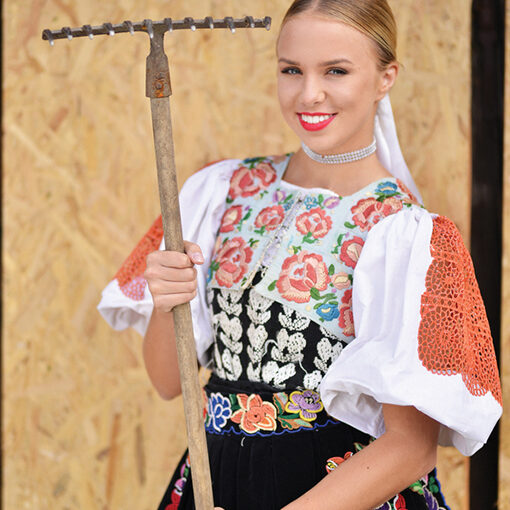A folklore look is a style inspired by peasant dress. The term “folklore look” came into use around 1970. However, fashions drawn from peasant costumes have appeared numerous times in the last one hundred years.
Early Peasant Looks
Artists, writers, and political activists who settled in New York City’s Greenwich Village after 1910 adopted peasant blouses and farmer’s smocks to signify their leftist sympathies. Embroidered blouses, sold in Hungarian and Russian shops, became almost a uniform for bohemian women.
The trend for geometric embroideries on gauzy fabrics coincided with a period in fashion history of clothes with simple shapes and elaborate decoration. Many blouses, delicately embroidered with Slavic motifs, survive from this period in museum collections.
Motifs
Folk-inspired motifs and shapes appeared in other apparel as well. Sweaters frequently took their inspiration from folk designs, such as the Fair Isle patterns popularized by the Prince of Wales in the 1920s. In the 1930s, skiwear designers looked to Scandinavian, Swiss, and Austrian models for trousers, jackets, sweaters, and caps to wear for this newly fashionable sport.
The designer Elsa Schiaparelli included Austrian Tyrol looks in her collections. Peasant styles occasionally sprang from resorts frequented by the rich and famous, such as men’s embroidered shirts from Mexico, or ponchos suitable for wearing as beach cover-ups or on board ship.

Designers and the Folklore Look
Designers inspired by street styles brought the folklore look to high fashion in the 1970s. The English designer Zandra Rhodes observed that in the late 1960s, with the Beatles in India and the Rolling Stones in Morocco, “folklore was appealing”.
She found the peasant embroidery and the simple shapes of ethnic clothes “infinitely pleasing” and began creating dresses with ethnic shapes for her hand-painted textiles.
Before long, the Paris couture got in on the act, particularly Yves Saint Laurent. His Russian collection of 1976-1977 featured rich peasant looks with full skirts, corselet-type bodices, and short decorated jackets in luxurious fabrics trimmed with fur.
This collection introduced colourful scarves, shawls, ruffled skirts, and boots to mainstream fashion.

Functions of Folk Dress

In 1971, Petr Bogatyrev published his influential study The Functions of Folk Costume in Moravian Slovakia. A proponent of structuralism, Bogatyrev argued that peasant clothing may be interpreted as a language that communicates a number of functions. These functions express attitudes within the community regarding social, aesthetic, moral, and nationalistic ideals. His observations regarding the wearing of folk dress, some of which are summarized below, apply to all of eastern Europe.
- Folk dress signifies a special day, such as Sunday, holiday, or ceremonial day. Clothing for brides and grooms are among the most elaborate.
- Folk dress indicates the occupation of the wearer (for example, shepherd).
- Folk dress distinguishes wealth and social status, typically through the number and quality of clothing items.
- Components of folk dress have a “magical” function. For example, the ritual marriage cap placed on a new bride brought fertility and good fortune.
- Folk dress signifies regional and national affiliation.
- Folk dress may indicate religious affiliation.
- Age and marital status is communicated by folk dress. Contradictory situations in peasant society, such as single motherhood, are visible in a woman’s appearance.

